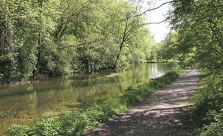Just eleven months ago we had a riveting talk by Christine called “Brown Hares In The Peak District” and if anything this talk was even better. The story was about a Peak District River called the River Bradford in the White Peak.

We were taken on a journey from its source in Gratton Dale through Bradford Dale to the point at which it meets the River Lathkill, east of Youlgrave. Visitors in their hundreds enjoy the picturesque beauty of the dale all year round but Christine explained that it was not always like that. The River Bradford was a source of food and power for industry going back to medieval times.
The first part of the river is known as Rowlow Brook until it reaches Moatlow in Upper Bradford Dale and then its name changes to the River Bradford. This area of the river was rich in wildlife but intensive farming had a disastrous effect reducing the bird population and wild life by 50%. Cattle also trampled down the river banks destroying the homes of the Water Vole. However recent conservation of the area is having a positive effect and all types of life are returning. Below Youlgrave the river widens out because it was dammed in medieval times to create fish ponds for food.
Lead has been mined in this region since medieval times and as the workings got deeper it became necessary to drain them by digging drainage tunnels known as soughs; but these soughs altered the balance of water in the region. Hillcarr Sough, which was started in 1766 took twenty one years to dig and at four and a half miles is the longest in Derbyshire.
In 1882 the River Bradford disappeared down a mine shaft and flowed straight down Hillcarr Sough. Attempts were made to block the hole with cart loads of stones without success but eventually it was sealed with brushwood but hydrologists believe that the disappearance of the river in times of drought can still be blamed on the giant drain.
Apart from lead mining there was also a factory at Goose Holme making red tape, ribbon, pill boxes, and bobbins. This area looks picturesque now but it must have been terrible in the 1800s.
Christine’s talk was a very short precis of her new book called “A River In Time” and this blog does not do it justice. You can find out more about Christine and the book by visiting http://cg.barefoot-hosting.com/my-work/a-river-in-time/
